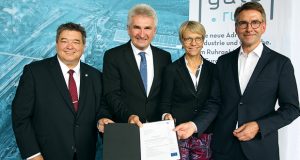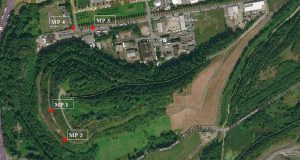After the Saxony Minerals & Exploration AG (SME AG) exploratory shaft in the Luchsbachtal Valley near Pöhla/Germany in the Ore Mountains has reached its final depth and preparations to exchange the previously leased hoisting winches for owned winches are in full swing, the comprehensive approval process for the planned mining installations and for the necessary spoil tip continue to run in parallel. In the context of the required general operating plan and regional planning procedures, specialist environmental planners from the Pirna/Germany based company “Schulz UmweltPlanung” have been commissioned by SME and have now compiled the required environmental impact assessment, the planned conservation and compensatory measures and a plan for the rehabilitation of the site following the end of mining activities. Further species surveys are currently being conducted.
Especially against the background of the imminent visit by Vice President of the German Federal Parliament Katrin Göring-Eckardt (MdB B90/Grüne) and today’s comments by Stephan Kühn (MdB B90/Grüne) in the “Freie Presse” newspaper, which juxtaposed “maximum profits for mining companies against maximum losses for residents and nature,” the company has been unjustly discredited. “We have invested lots of time and commitment and the specialist knowledge of the top environmental experts in the Free State of Saxony, as well as – in association with this – money, of course, in conforming with all legal requirements relating to conservation and to reduce any harmful effects on nature to a reasonable minimum,” according to SME spokesman Stephan Trutschler. “We consider these attacks, without having even had a single discussion with representatives of the mining company, to be rather pointless. Germany is a high-technology location with an enormous consumption of rare earths and ores. We could of course also continue to extract these on a large scale from the mines of Central Africa and Latin America documented child labour and/or work under catastrophic environmental conditions – and then have it shipped halfway round the world to us. Whether this is actually what a green sustainable policy should look like, I very much doubt,” Trutschler continued. In his view, we should not omit from consideration the fact that in the medium term, around 150 jobs will be created in a structurally weak region – 36 full-time staff are already employed – and that numerous suppliers and other service-providers will also benefit from a company in this segment. “I absolutely do not wish to speculate here about the business tax which will then substantially benefit the city purse and the surrounding municipalities,” Trutschler concluded.
“We are of course aware that our planned mine is a not-insignificant encroachment into the landscape of the Luchsbachtal Valley,” explains Klaus Grund, Technical Director of SME. “Therefore we will naturally do everything we can to keep the effects as minor as possible during the operational period of the mine and to employ landscape and species conservation measures during and after mining activity to protect the natural environment of the valley and to eventually restore it as far as possible.”
The specialist environmental planners from Pirna particularly focused on the compensatory measures for the planned minerals processing plant, the accumulation on the tip which is already in existence and on the diversion of the Luchsbach stream. Since woodland areas will have to be cleared for the new spoil tip, the planners say that a larger area outside the Luchsbachtal valley must be turned into a woodland, although the precise area has not yet been determined. Following the operational period of the mine, the tip must also be re-forested and extensive grassland areas created. In order to exclude the possibility of ground erosion, tip accumulations and clearings will also only occur section by section. Furthermore, as compensation for the use of a meadow for the processing plant, a wildflower meadow for insects will be developed and cultivated close to the Zinnkammern visitor mine. The visitor mine and the Morgenstern visitor gallery will remain accessible throughout the entire operational period, and the forest and hiking paths will also remain open, even if sometimes diverted.
According to the studies, apart from the construction phase for the erection of the plant, the effect on traffic for the people of Pöhla will be limited, since once the mineral processing plant is in operation, only the selected raw materials concentrates will need to be transported away. Also, the processing plant will be set up in a closed building, which will also contribute to preventing noise pollution.
The environmental planners do not foresee any difficulties in relation to the issue of groundwater, either. The intention to pump away the groundwater in the immediate area of the mine will also not lead to any lowering of the groundwater table, as in previous mining eras. Also, the water pumped off will be regularly checked before feeding into the watercourses, and the daily volume discharged will be restricted.
In addition to the establishment of a substitute meadow biotope, further conservation measures are also possible, according to the environmental planners. However, numerous species studies should be undertaken on-site beforehand, as agreed with the Erzgebirgskreis district local conservation authority.
“The experts from Schulz Umweltplanung have done a thorough job. When the responsible authorities have all the required documentation shortly, we hope that the approval process can be concluded swiftly,” Grund concludes. (SME/Si.)


